






Thank you for joining us for the Winter 2023 issue of BizAvJets USA. Once again, we are thrilled to present informative articles and some of the latest news updates in business aviation. With pilot and aircraft mechanic shortages, there are job and business opportunities galore!
While the aircraft sales market might be softening with the recent recession, there are still plenty of opportunities to grow and improve your business. We are here to provide resources to help you accomplish your goals.
This month, we tell the story of FlyAir on our cover. This is a dynamic aviation startup with big plans for the future! Next, we focus on aircraft maintenance with two stories of self-made entrepreneurs. Both ToughGuard and Shiny Jets talk about the importance of quality products and aircraft upkeep. Their stories are sure to inspire you to head into springcleaning mode just a tad early.
Up next, we have the story of Jet It, a unique jet-sharing experience company serving some of the best and brightest in business. If you are frustrated with commercial airliners and unsure of where you fit into flying private, Jet It might just be the solution for you.

We also offer news releases from IADA, Million Air, and NBAA to keep you up to date on the market, new products and services, and the latest trends in business aviation. So while the economy might be a bit down in the dumps, we here at BizAvJets USA are optimistic that this industry is filled to the brim with opportunities. Where will you go next?
Sincerely,
Annamarie Buonocore and Elijah Stepp Co-Publishers BizAvJets USACo-Publishers
P.O. Box 5402, San Mateo, CA 94402 (650) 358-9908, Fax (650) 358-9254
Annamarie Buonocore and Eli Stepp (702/465-2027)
Managing Editor Vickie Buonocore

Production Editor Matt DuBois
Columnists
John Goglia, Mark DiLullo and Matt Odenbrett
Advisory Board Member Bert Botta
Business matters, advertising and editorial concerns should be addressed to In Flight USA, P.O. Box 5402, San Mateo, Calif. 94402 or by calling (650) 358-9908–fax (650) 358-9254. Copyright © 2008-2021 In Flight Publishing.
BizAvJets USA is not responsible for any action taken by any person as a result of reading any part of any issue. The pieces are written for information, entertainment and suggestion – not recommendation. The pursuit of flight or any action reflected by this paper is the responsibility of the individual and not of this paper, its staff or contributors. Opinions expressed are those of the individual author, and not necessarily those of BizAvJets USA
All editorial and advertising matter in this edition is copyrighted. Reproduction in any way is strictly prohibited without written permission of the publisher.
BizAvJets USA is not liable or in any way responsible for the condition or airworthiness of any aircraft advertised for sale in any edition. By law the airworthiness of any aircraft sold is the responsibility of the seller and buyer.
Here at BizAvJets USA, we are big on products that work and get the job done. Aviation is a tough industry, and aircraft experience some harsh elements at times. That is why products like ToughGuard come in handy when it comes to washing and detailing aircraft of all kinds. We had the pleasure of talking with Dan Reid, owner of ToughGuard, and learning about his company. We hope you find the ToughGuard story and product line useful when it comes to caring for your aircraft.
BizAvJets USA: Tell me a little bit about the history of ToughGuard and how you got started with this product.
Dan Reid: The ToughGuard product has been around for more than 35 years. There was a gentleman up here in Oregon who was very involved in aviation and auto detailing. He started the product and then started distributing it throughout Oregon and into California. That was when I became a distributor of the ToughGuard product. The distributor network became larger and larger, and soon the product was being used on Air Force planes. It has been Air Force tested. After a few years, the owner of the company came down with some health problems, so he approached me to see if I wanted to manage ToughGuard. I gladly took it on, and that is how I got here today.
BAJUSA: Tell me a little bit about how the product works.
DR: We have a two-step process. The first step is to give the vehicle or aircraft a good wash. Then you apply the product to wax and wash. It is a bit of a different
process from regular waxing where you wax on and wax off. Then you let it sit anywhere from a half hour to a couple hours. Then you can take it off. We have had very good results over the years and have never had a customer complaint. We have a 98-percent satisfaction rating. This product really protects the paint of the aircraft.
BAJUSA: Who is your target market?
DR: While we sell to private aircraft owners, our real market is B to B. We try to sell it in bulk to corporations with large flight departments or fleets of aircraft.

BAJUSA: Would you say this is an environmentally friendly product?
DR: I would say that it is. It’s non-toxic and gentle on the skin. It’s packaged in recyclable plastic and is overall an environmentally sound product.
BAJUSA: I understand you have been in contract with car companies such as Ford and Volvo. Have you been in contract with any aviation companies?
DR: Yes, several have purchased the product. We recently contracted with Embraer, and they love it. They did a before-and-after test and were very pleased with the results. They are currently using it on all of the jets in their fleet. We recently started working with Dassault as well, and they are also very pleased.
BAJUSA: How is it sold?
DR: It is usually sold in tubes, but it can be purchased in a gallon jug. We can also do large bulk packages of
Continued on Page 5
Continued from Page 4
whatever the customer wants. It is a gel-like conditioner.
BAJUSA: What color is it?
DR: It is naturally white, but we have a touch of blue dye because many airplanes are white, and we want the user to be able to see where they have applied the product.
BAJUSA: How can our readers purchase it?
DR: They can purchase it directly through our website www.toughguard.com. We usually sell it directly to companies. It is great for anything with a Part 135 or corporate flight department. In the aviation industry, we sell it to maintenance companies and detail shops.

BAJUSA: Thank you. For more information, visit www.toughguard.com.
Annamarie Buonocore is the co-publisher of BizAvJets USA magazine. She enjoys writing, everything aviation, and spending time with her two dogs. She can be reached at annamarie@ bizavjetsusa.com.


ToughGuard has a 98 percent satisfaction rating, according to customers who say the product protects the aircraft’s paint. (Image courtesy ToughGuard)

 By Annamarie Buonocore
By Annamarie Buonocore
Anyone who has ever owned an aircraft or been involved in aviation can agree that aircraft ownership is a big responsibility. When we think of aircraft maintenance, we often think of engine logbooks and keeping the avionics up to date. One area of maintenance that is often overlooked is bodywork and detailing. In this interview, we had the opportunity to talk with Brett Berry of Shiny Jets, a San Diego-based aircraft detailing company that has taken detailing to new heights. Brett and his staff work tirelessly to keep airplanes shining, and they have also started an educational program all about maintaining the cosmetics of aircraft. There is much to learn, and we look forward to exploring the different options available in this interview.
BizAvJets USA: When did you get started with Shiny Jets?
Brett Berry: I got started in this business four years ago.
BAJUSA: What made you want to get into aircraft detailing?
Bret Berry: I had a previous aircraft detailing business that I started. I had it for eight years and then sold it. During my time in the industry, I noticed a lot of poor work on other aircraft. I would see things from customers’ aircraft that were terrible. There is not a lot of information on how to restore and maintain aircraft correctly.
BAJUSA: What is the most common type of aircraft that you service?
BB: I would say Gulfstreams, King Airs, and Citations. More on the business jet side…
BAJUSA: So you are based in San Diego. Are you at a certain airport there?
BB: Yes, we are at Palomar, Montgomery, and Gillespie. We have several locations within the San Diego area, and we also have some out-of-state locations, including Mesa, Arizona; Jacksonville, Florida; Las Vegas, Nevada and Dallas, Texas.
BAJUSA: Tell me a little bit about your detailing process and what sets it apart.
Continued from Page 6
BB: What I run into a lot is that many detailing companies will not provide the quality job that will make their work last longer. For instance, they will compound the paint and then polish it, but when they were compounding, they did not remove all the oxidation. Aircraft paint deteriorates more than typical car paint. In six months, that paint will look chalky and ugly like it did before. Their compounds and polishes have fillers, so it looks really good in the beginning, but then the gloss wears off after a couple of washes, and it just looks old and chalky. Aircraft paint typically does not have a clear coat.
BAJUSA: What advice would you give to aircraft
owners?
BB: I started Shiny Jets to start educating the industry. I have done interviews on YouTube, TikTok, Facebook, and other social media sites to educate people with tips and tricks that they can do themselves or how they can notice when their detailing person is not doing it properly. They will notice when the mechanic uses a cloth with metal shavings in it to wipe down the aircraft, and they will see how that scratches the paint. I set out to help the industry grow and get better results. I want to preserve aircraft for longer and make the cosmetic surfaces last longer. Unfortunately, the auto industry has surpassed aviation by leaps and bounds; so many of the methods you see out there are outdated and ineffective. They should listen to our podcast, watch our YouTube, and take our online courses for individual services. We have a full-fledge online course on how to build an aircraft detailing business. You can also come to one of our in-person trainings. Many people learn how to detail just by watching our content.
BAJUSA: What advice would you give to those who desire a career in aircraft detailing?

BB: I would say start learning how to detail cars. Work at a carwash. Even take a flight lesson to learn more about aircraft. It will give you a humbling experience. See if an aircraft detailing shop is willing to hire someone. You have to start off at the bottom, washing the bellies, etc. You have to start at the bottom so that you can move up in the company and offer that company a quality finished product. Safety is number one in aviation, and you need to show that company that you take it seriously.
BAJUSA: Are you hiring?
BB: Yes, we are. Contact us today.
BAJUSA: Is it better to hire a service or to do it yourself?
BB: I would say that it depends on the size of the aircraft. Many pilots do it themselves. I would recommend taking my ceramic coating course online. It might be cheaper to take the course and then tinker with your plane over the weekend and do it yourself. If it is a larger jet, you will want a team to work on it to get it done faster.
BAJUSA: How much does it cost to take one of your courses?
BB: Right now, our online course is $2,000. It takes about 10-12 hours to complete. You can take it at your leisure. Our in-person training is actually a hybrid course. They complete some of it at home online and then come to our headquarters. We cover light meals and lodging. We have shuttles that go to and from the airport where we detail planes for three days straight. They come in educated because they took the online course.
Continued on Page 8
Continued from Page 7
Now they’re just doing the hands-on part. We also do private trainings and have for quite a few Fortune 100 companies who need to train their staff right out of their facility. We curtail the training to their specific aircraft.
BAJUSA: What is your personal favorite aircraft to work on?
BB: I would say warbirds. I have a customer who has 28 warbirds that still fly. I have restored every single one of them cosmetically.
BAJUSA: Do you work on many helicopters and how are they different from fixed-wing in terms of detailing?
BB: I recommend that every detailer have a briefing on any aircraft they wash or detail. This way they know the sensitive areas and the chemicals they want you to use or not use. We always read and educate ourselves with the maintenance manuals before detailing them. Yes, I do a lot of helicopters. We try to remove the exhaust stain or polish the windows. Here in Southern California, many helicopters are fighting fires, so they get abused fighting fires on the paint and windows. We
are restoring windows roughly every six months for all the fire helicopters here in the local area.
BAJUSA: What are your plans for the future?
BB: We are looking to build more locations. We are in the process of filming a new online course that is so in-depth that it is mindboggling. I put a GoPro camera on and make it really hands-on even when it’s online. We plan to translate our training into different languages for different countries. We plan to come out with our own product line to pass Boeing’s specifications. Nearly 60 students have gone through our training program thus far.
BAJUSA: Do you have anything else you would like to add?
BB: Yes, I travel the country doing cosmetic services on aircraft, and I look forward to continuing my travels.
Annamarie Buonocore is the co-publisher of BizAvJets USA magazine. She enjoys writing, everything aviation, and spending time with her two dogs. She can be reached at annamarie@ bizavjetsusa.com.
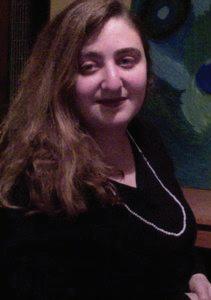
In Flight USA had the pleasure of interviewing Anna Zavrazhnova of XL Aviation in Livermore, Calif., recently. Anna is a very accomplished pilot, especially since she started her training under difficult circumstances in Russia. She came to the U.S. and completed her training, while learning English, and now sees XL Aviation as her second home. XL’s mission is to train pilots to be better and safer in the air and on the ground. Their fleet of aircraft and expert flight instructors provide exactly what you need, and meet you where you are in your training, even if you started your training in another country and are learning English, like Anna. They offer flight training in aerobatics, onset upset recovery, and air combat maneuvering. Also, they offer solo aircraft rentals and aircraft type certifications at all levels.
BizAvJets USA: The first question I have for you today is tell me a little bit about yourself and why you wanted to come here to the USA to learn to fly?
Anna Zavrazhnova: I’m originally from Russia and
I started to fly in Russia but it was very complicated. It is very corrupt. I had to work three jobs to be able to fly just 20 minutes per week. I couldn’t get my license there. In Russia, you have to be in a school that is approved, like an FAA-approved school here, but there are less then 10 in the entire country and you have to pay a lot of money to get the license. It just so complicated and there wasn’t a school I could go to so I was in a club, not any kind of regulatory approved school, but just a club. I just couldn’t get a license legally. I did not come here alone. I came here with my husband. If it wasn’t for flying, I would have never thought of leaving Russia. I have my family and my friends there but when my husband said we should think about coming to the U.S., I thought about flying and I agreed.
BAJUSA: Does your husband also fly.
AZ: No, he’s an IT guy. I came with him because the Silicon Valley is where it was good for him to be.
Continued from Page 8
BAJUSA: What made you chose XL Aviation in Livermore as your flight school?
AZ: I started with one of the CFI’s who work here. A Russian friend recommended him. I started with another school but I didn’t really like it. It was also kind of expensive. Then I found a Facebook page for Russian pilots of the Bay area and I asked some questions. Someone introduced me to an instructor that works here at XL and he’s a very good instructor. I got my license with him.
Our first introductory lesson with him was in a Decathlon. I really like aerobatics and I always wanted to fly aerobatics. We went up in the Decathlon and I enjoyed riding with him. Then I did my training in a Cessna and got my license in about a year and then I quit instruments and started to fly aerobatics. I was working on my instrument rating but quit for a little while to do some aerobatics and I went to some competitions, one in Coalinga (central Calif.) and I placed second. And then I started my instrument training again. So now I’m doing both, instrument and aerobatics.
BAJUSA: That’s what is so great about this school. They do a lot of aerobatic training and they have access to those kinds of planes. Is aerobatics your favorite kind of flying?
AZ: Oh yes, this is my favorite kind of flying. My favorite planes are aerobatic planes. They are hard to fly and hard to land and it was hard for me to get checked out in it. The Decathlon is pretty easy to land but hard to fly aerobatics in the sky, with huge wings and little ailerons. You have to be pretty good to fly them well. Aerobatic flying is very sensitive.
BAJUSA: Does your instructor still work here at XL.
AZ: Yes, he still works here. He works here full-time and he’s very busy. I brought all my Russian friends here. They all fly with him. He also has the TSA “Permission to Initiate Training,” regulations papers. When you’re a foreign student, you have to get the TSA permission for flight training. If you’re an instructor you have to apply for this and he has the formal knowledge and ability to train foreign students. We actually have a lot of people from all over the world here at XL, Russian students, students from India and many places.
BAJUSA: Do you want to make aviation your fulltime occupation and career?
AZ: I always wanted to fly. It was my dream from my childhood. My great-grandpa was a World War II pilot. I want to get my commercial license and maybe in-
struct here as a CFI. I never wanted to fly for the airlines but I enjoy recreational flying, especially aerobatics.
BAJUSA: You mentioned you were already in a competition last year. Tell me more about that.
AZ: Yes, I was in Coalinga last year and got second place and then I was in Tracy (Northern Calif.) this year and I moved up to Sportsman (category) and I placed ninth. I didn’t train well or as much as I wanted before this competition. I’m hoping to be training more and to get better results. I’m planning to go to Redlands for another competition. I hope to do better. We have a lot of planes here and they are on leaseback so we can train in those for the competitions.
BAJUSA: What advice would you give to aspiring pilots and people who want to learn how to fly?
AZ: I want to say don’t give up. It was very hard for me. When I started to fly, I didn’t have much time. I was working immigrant jobs, like babysitting, and I didn’t speak English very well. My English was very poor. When I first started, I didn’t understand a single word my instructor was saying to me. My instructor would say, “you’re not understanding anything, you can’t get a license.” But I did start to understand and I did learn and I got my license in a year… not too bad! And during that time, I had to take some breaks because of the fires in California. So don’t give up. You can do it!
BAJUSA: Why would you recommend XL, what sets it apart?
AZ: Its special. The atmosphere is different here. I was in other schools and they were about business, you get your papers and you go to the hangar. You never see a mechanic. But here, we’re all in one place. You see the owners and you see mechanics. The receptionist is here. There was a student who came here because he failed his oral exam. He was asked about engines and so he was frustrated because he never met a mechanic at his old school. He felt he needed to know more about engines. Here, I was standing right there with the mechanic and he was changing oil and so I just asked him about it. He could explain everything.
This atmosphere is like a community and a family. In a big flight school, pilots just don’t get to know each other. Everybody knows everybody here. John (Degennaro) is the Chief Pilot and he has flown in international aerobatic competitions. He always wanted to fly a Pitts and now he teaches aerobatics. Allen (Crabill) and Lynzie (Hudson) are great instructors. And Michael Becker is a CFI, CFII and MEI. He has given more than 7,000 hours of instruction. Mike (Henderson), the owner, is always helping people, along with the instructors and everyone. He believes in me and always supported me. He even gave me a block of hours to prepare for my first competition. He does that with many of us. He helps all people
Continued on Page 27





A Chat with CEO Stuart Bullard by Eli Stepp
BizAvJets USA Magazine personnel meet the most interesting people serving the business aviation industry. One such person is Stuart Bullard, CEO of Fly Air, Inc. When we met him at 2022 NBAA in Orlando, we immediately knew we wanted to interview him for our publication. Mr. Bullard agreed to meet with us to share his story, and his involvement in business aviation.
Stuart Bullard has quite an interesting background. Highlights include demonstrating his musical talents on Mister Rogers’ Neighborhood at a very young age. During his youth he mastered 13 musical instruments and is a classically trained violinist. His musical accomplishments include the creation of the “Pittsburgh Sound” defined as a smooth blend of classical music, hip-hop, and rhythm and blues. As a music executive he collaborated and/or produced multi-platinum albums with highly recognizable names such as Dr. Dre and Snoop Dogg. He then chose to move on to the aviation industry becoming a jet-rated pilot, computer coder and by founding Fly Air, Inc. The firm created the “Fly Air” app in 2020 which allows individuals or groups to book charter flights with the option to pay with electronic wire, credit card, or with multiple cryptocurrency choices.

BizAvJets USA: Eli Stepp of BizAvJets USA Magazine here and we are very excited to be with Stuart Bullard of Fly Air, Inc. Thanks for being with us Stuart!
SB: My pleasure. Happy to be here.
BAJUSA: I’ve looked forward to this interview since meeting you and the “Fly Air Crew” at the 2022 NBAA in Orlando.
SB: This is exciting stuff. Thank you for contacting us for an interview. I appreciate our time at NBAA.
BAJUSA: Sounds great. Please tell us a little bit about yourself and your background.
SB: Absolutely. I am originally from Pittsburgh, Pennsylvania. My parents were mostly in government contracting. My father was an Air Force pilot and worked for the Department of Defense. My mother served in National Disaster FEMA type activities for the Veterans Administration. My brother served in the FBI. Then there is me, who was inclined to pursue my passions in music. I spent my younger years at an air force base. I was classically trained at the Pittsburgh Symphony Youth Program. I grew up in the music scene and then moved out to Los Angeles. I landed a record deal with Dr. Dre and signed a contract with him to produce records at Death Row and at Aftermath Entertainment. I did well for 25 years in the music industry, eventually having passive income with recording studios.
BAJUSA: Very impressive. What came next?
SB: I basically took a break from music and concentrated on becoming a type-rated pilot on multiple piston and jet aircraft. An old friend of mine said, to know the business of aviation, you should become a pilot. As a pilot you have the opportunity to touch so many points of business aviation to include servicing, maintenance,
Continued on Page 12
Continued from Page 11
aircraft management, sales, acquisition, charter, and fuel procurement. Additionally, you’re with the clients all the time, being entrusted with their business colleagues, and families, and everybody else. I also amassed myself to become a computer coder. I now code in four different languages and have become very proficient in autonomous software programming for drone systems. During this time I have met new contacts and made new business connections, some who have partnered with Fly Air, Inc. Our firm has been creating solutions for the business aviation industry. The first one is an application called Fly Air which essentially allows clients to book private flights using voice integration and artificial intelligence with a query system providing available private jets on demand in a matter of seconds. Clientele using the Fly Air app have the option of paying by credit card, multiple major cryptocurrencies, or with our very own Fly Air token. We are promoting Fly Air through traditional channels such as NBAA, however, we have started to socialize at events like Art Basel International Art Fair, Sundance Film Festival, and even sports events like Formula One in Abu Dhabi in Monaco, and cryptocurrency events such as Coin Agenda.
BAJUSA: Your story is inspirational and motivating! Let’s take a deeper dive about Fly Air Inc and the Fly Air app.

SB: Absolutely. We wanted to position Fly Air as an innovator and a disruptor in the private aviation industry. Basically, we leveraged our leading edge technology to offer the best customer experience. Our technology is leveraged to bring artificial intelligence and voice integration together. We brought the best of developers on board to include our Fly Air CTO who is also
a SpaceX developer, and a front-end developer who is also a SpaceX developer. They both worked on the Starlink program. We are very happy to have them on board to provide rigorous code-based technology. The Fly Air app took us about a year to develop which includes a chat system, and a secure back end with a wallet. We built a nice integrated system that allows us to source over 300 fixed base operators around the globe. Our APIs connect with over 10,000 jets around the globe. The app will filter results based on client requests geographically. All Fly Air charter operator partners are top-tier Argus and Wyvern approved organizations. Essentially we source flights like Amazon sources products to clients. We are also very pleased with the group feature in our app which works in two modes. One mode allows the client to pay for the flight up-front and invite passengers, and another where each passenger can pay for his portion of the flight individually. The group features are handy when going to networking events together. To sum it up, we’re a tech company providing solutions to the aviation industry.
BAJUSA: Very informative. One topic that comes up a lot within the aviation industry is the environmental footprint of flying. How does the Fly Air team think about this challenge?
SB: I am so pleased you asked. We are extremely passionate about protecting our environment. I am convinced most individuals are as well. The first point is that we make it easy for clients who utilize the Fly Air app to have an option here to mitigate the carbon impact of flying via carbon offsetting. When a flight is booked, an algorithm in the app generates metric tons of carbon emissions per passenger during the flight, and a fee for offsetting passenger carbon emissions is then included in the booked flight. This feature removes the burden on the individual to find a way to offset their carbon emissions incurred from the flight. Additionally, passengers are informed about which real, pro-climate projects their fees support. For example if they are helping to protect vulnerable regions from deforestation, or supporting reforestation and tree planting efforts. Importantly, they feel confident about the fact that their funds are verifiably supporting these initiatives across the globe. Fly Air, Inc. has a contractual partnership with carbon offset organization KlimaDAO (www.KlimaDAO.finance) that facilitates the carbon offset process.
For us, carbon offsetting is the starting point for the aviation industry to mitigate its environmental impact, but we’re also excited to see how the industry will evolve to and become increasingly environmentally efficient as new low carbon technologies and innovations become available. As a tech provider for the industry, we think we have a role in supporting this transition over the coming years.
Continued on Page 13
Continued from Page 12
BAJUSA: Does your partnership with KlimaDAO limit you to Carbon Offsets for Fly Air only?
SB: It does not. In fact, we are currently building online infrastructure enabling carbon offset processing to all private aviation, charter, and airline entities through our KlimaDAO partnership.
BAJUSA: Wow, that is a huge market.
SB: Indeed. We are very excited about our future in the carbon offset market, and the positive impact that we can have by helping scaling these solutions!
BAJUSA: What do you see in the immediate future for Fly Air?
SB: One of our very interesting initiatives is the multi-tiered membership we are launching soon.

The current model is a basic tier free membership for anyone who downloads the Fly Air app, a mid-range tier that is earned by reaching a certain flight level via the app, and a top tier level which is an invitation only paid membership. The top tier level will provide special offers, and exclusive invitations to private special events similar to SoHo lifestyle gatherings, (www.sohohouse. com) professional sporting events on a suite level, and an annual party to announce new features and share new Fly Air initiatives.
BAJUSA: Would I be correct to assume Fly Air is seeking investors?
SB: Absolutely. We have done multiple types of fundraising to include our system back-end AI resource protocols, virtual calls, and in-person. Our initial funding round was relatively fast raising $1 million dollars in six months. We continue in discussions with investors as we speak.
BAJUSA: Great. Is there anything you would like to add?
SB: Basically, look out for us in this space. We have an exciting experiential setup. We have an amazing application. Our mobile app is currently IOS available in the Apple App Store. Android and Desktop versions coming soon. Our website address is FlyAir.IO
BAJUSA: Mr. Bullard, we appreciate your time. Thank you for being with us. Best wishes to you and Fly Air, Inc.
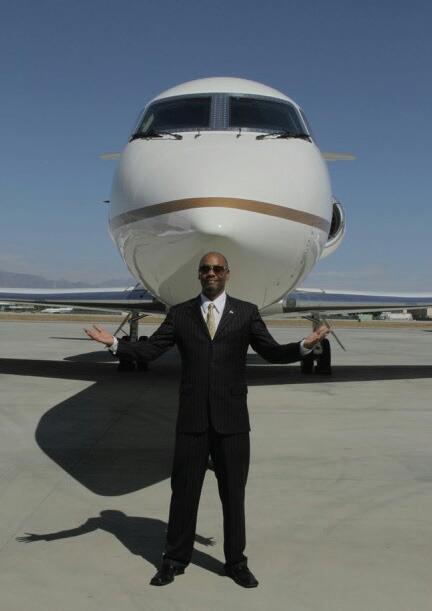
SB: Thank you. I appreciate the opportunity.
Eli Stepp has served the Business Aviation Industry for more than 40 years. In addition to founding BizAvJets Inc., and co-founding BizAvJets USA Magazine, he continues to serve the BizAv Industry on a full time basis in multiple roles.



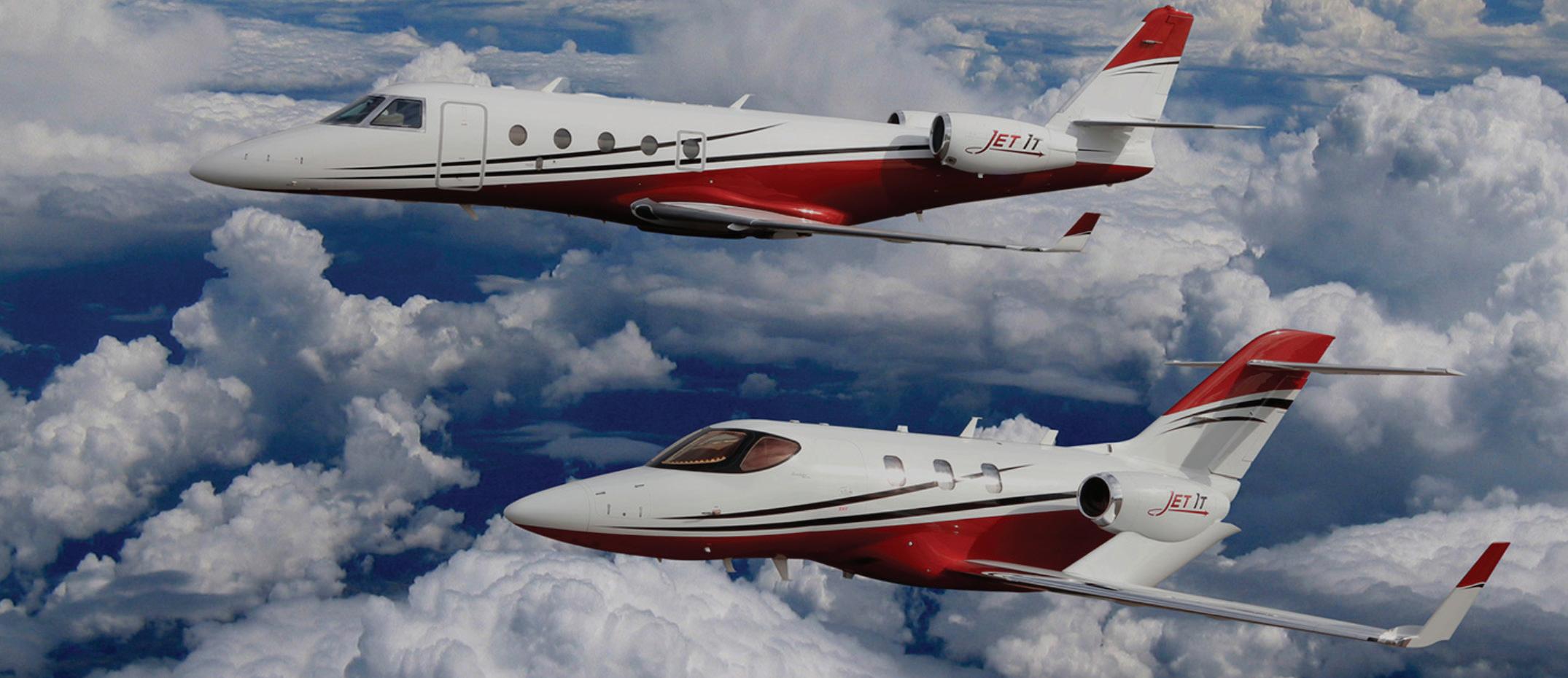 An Interview with Glenn Gonzales By Annamarie Buonocore
An Interview with Glenn Gonzales By Annamarie Buonocore
Here at BizAvJets USA, we stand by the message that flying private isn’t just for the rich, famous, and notorious. In today’s world, it really can be for anybody. Membership and fractional ownership programs are making that possible. After the pandemic, many commercial passengers took an interest in private flying to avoid crowded planes with strict mask mandates. For those who have always seen private flying is out of their range, stay tuned for this interview with esteemed entrepreneur, Glenn Gonzales, of Jet It. Jet It is a fractional ownership company that is making private flying dreams come true for 47 percent less than other companies.
BizAvJets USA: Tell me how the Jet It business model works.
Glenn Gonzales: Jet It is designed to support individuals and give people the benefits of aircraft ownership. When you own your own plane, you can use that plane at your discretion. In many fractional ownership models, you have to wait a long time, and when it’s your turn, you only get to use the plane for a few hours. When you are a part owner through Jet It, you get to use the plane all day at your discretion. What that does is create more aircraft availability, and when you apply that to our price point, it becomes a great deal. It is almost like having aircraft ownership at a fraction of the cost.
BAJUSA: What made you want to start a fractional
jet ownership company?
GG: I have been around aviation my whole life. I started my career in the Air Force. I flew fighter planes in the Air Force and then transitioned to flying Gulfstreams around the world. I really enjoyed selling airplanes. When I was selling airplanes for Honda Jet, I saw an opportunity where people were looking for a solution to meet their needs. It was really a response to customer wants and needs. People would look at the Honda Jet and think it was a great plane, but they did not have the need or the budget to purchase a whole plane. That was when I saw the opportunity to start a fractional ownership company. The Honda Jet is such an efficient aircraft that it just made sense for fractional ownership.
BAJUSA: How long have you been doing this?
GG: We started on Labor Day of 2018 and received our first airplane in Dec. of 2018. We have been at it ever since.
BAJUSA: Who makes for an ideal client at Jet It?
GG: We have four customer types: recreational flyers, business flyers, corporate outfits that already have airplanes, and then there are the owner/pilots. I would say most of our customers are entrepreneurs. They are individuals who have been able to find an opportunity for their business and expand it beyond a city to a state or throughout the country. Whether they are flying rec-
Continued from Page 16
reationally or for their business, they have a need for consistent private travel. More often than not, they can afford to belong to other programs or to buy their own airplane, but they usually can’t justify this. So, they see a great opportunity to enjoy a program like Jet It.
BAJUSA: How many employees do you have and are you hiring?
GG: We are hiring. Right now, we are just under 200 employees. We have seen very fast growth in a very short period of time. Our employees are spread throughout the country as well as in Canada and in Europe. We have a sister company called Jet Club in Europe. That way, our owners can benefit from the service there. We are spreading to new states and countries all the time. We have grown so fast that it is hard to keep up sometimes.
BAJUSA: What is the primary airplane in your fleet?
GG: Yes, we have 25 airplanes in the U.S. We have one more in Canada, and one in Europe. There are 27 total. The majority of those planes are Honda Jets. Then we have two Gulfstream G-150s. We have been exploring adding additional aircraft to our fleet. This would give more value to our shareholders.
BAJUSA: How do you feel about electric aircraft?
GG: I am super excited. We actually have an extensive order and will become the first operator of electric aircraft. We are working with Bye Aerospace to develop a platform for local, regional, and coastal aircraft. We are supporting our customers as simplistically and transparently as we can.

BAJUSA: What do you like most about business aviation?
GG: We are a dynamic airline. There are variables that are constantly thrown at us, and challenges to solve daily, especially with the supply chain issues being experienced throughout the world. Weather, of course, is different everyday. Scheduling and orders are critically important. We want to make sure our employees and customers have plenty of time to spend with their families. It is this dynamic environment that makes it so exciting.
BAJUSA: Are there any myths about private aviation that you would like to dispel?
GG: Yes, I think when it comes to the customers, many people think that it is a celebrity industry, but most of the people flying on our planes are everyday people. You would never know their names. Once in a while, you might recognize the name of their company but probably not. It is no longer all about opulence. We provide a luxury experience and a high level of service, but this is more about convenience than anything else.
I would say the biggest myth is that one has to be very wealthy to take part in this, and that is no longer the case.
BAJUSA: Where are you based and why is that a good place for business aviation?
GG: We are based in Greensboro, N.C. It allows us to be close to Honda Aircraft Company. But our airplanes are flying all over the U.S. on any given day. We have a maintenance facility in Ellington, Tenn. Our dispatch and operations center is in Plano, Texas. Like our industry, we can be anywhere and are spread out all the time.
BAJUSA: Do you have anything else you would like to add today?
GG: At Jet It, we like to think of ourselves as on the edge of the evolution of transportation. People are looking for more autonomy and efficiency in how they travel. There is no longer a need to stop somewhere and wait for a layover. We can get you directly to your destination. You only have to fly with the people you ask to have on your aircraft with you, your business partners, family, and friends. With rising commercial prices and decreases in service, it’s just a tremendous opportunity to find this autonomy that so many people are looking for.
BAJUSA: Thank you!
Annamarie Buonocore is the co-publisher of BizAvJets USA magazine. She enjoys writing, everything aviation, and spending time with her two dogs. She can be reached at annamarie@ bizavjetsusa.com.
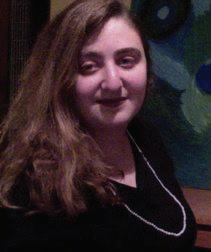

As more passengers are finding alternatives to commercial aviation, the FBO landscape is changing with a flood of mergers and acquisitions. While the names on the buildings may be different, the expectations remain largely the same. And with more and more passengers using FBOs, many are asking: What makes a good FBO? Several factors combine to make a good FBO, but most of those will support two basic principles: Anticipation and consistency.
Anticipation comes in many forms. In the short term, if a transient aircraft arrives late at night, the FBO should anticipate that the passengers and crew will need overnight accommodations and transportation. In the long term, good FBOs should anticipate seasonal weather changes and be prepared with all the salt spreaders, windshield scrapers, and deicing fluid long before the temperatures start to drop.
For a first-time customer, an FBO should be responsive to any pre-arranged services, and should be able to anticipate the aircraft’s basic requirements. A larger aircraft like a Challenger or a Gulfstream will have wildly different requirements than that of a small piston aircraft. Whether or not the FBO has all the capabilities, they should be ready to answer questions about hangar space, dish and linen services, potable water, ground power, and many other standards of ground servicing.
Consistency reflects the FBO’s training and internal communication. One great service experience is a product of many moving pieces, and should be repeatable. For repeat customers, the FBO should remember names and preferences for the passengers and crew. Good FBOs have strong internal communication methods to transmit this customer information across different departments, different shifts, and in the case of FBO chains, geographically separate locations. Not every employee will be a veteran with decades of experience, but the best FBOs will find ways to take the knowledge from the vets they do have and transfer it to each team member.
Unfortunately, even the best FBOs make mistakes. What separates good FBOs from the rest is not their lack of mistakes, but their ability to quickly respond to these events with compassion and solutions. Good FBOs empower all their employees to correct service issues instead of waiting
to get the manager’s approval. Good FBOs welcome feedback and have the mechanisms to capture and act on this feedback.
Many FBOs are now implementing Safety Management Systems, presenting an organization-wide approach to manage risks and measure the effectiveness of their controls. This approach to safety not only applies to the FBO as a workplace; the implementation of safe practices is passed on to the safe handling of aircraft and protecting the personal safety of aircrew and passengers. This SMS can be validated through a third party and registered under the International Standard for Business Aircraft Handling (IS-BAH).
A recent survey from a large fleet operator revealed that their passengers’ most important concerns are baggage handling, the quality of the FBO’s restroom, and vehicle access and parking. None of these should be a surprise. Most facilities will allow personal vehicles planeside, although some airports may not allow this practice. While this decision may be out of the FBO’s hands, they must make every effort to ensure the passenger’s vehicles are conveniently accessible.
Lastly, many of the best FBOs are known for their employee-centric company culture. It is no secret that happy employees will create happy customers. Although it may be hard to measure with Glassdoor reviews or local “Best Places to Work” awards, this aspect is critical in today’s fluid workforce environment. The best FBOs can recruit and retain the top talent required to tend to passenger’s needs and handle an ever-evolving fleet of aircraft.
The sum of a good FBO’s efforts should be a seamless service experience, no matter the time of day or time of year.
Jason Sahl is the Director of Safety for Million Air Interlink FBOs, with 20 years of FBO experience around the United States, serving in several operational leadership roles at FBOs large and small.
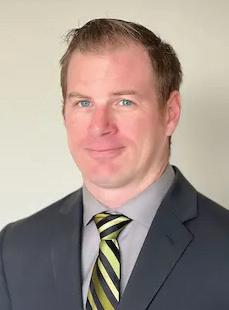



Coleman Jet Solutions, established in November 2021, is has announced that their team finished the first business year strong, by assisting its clients in closing five transactions in the last six weeks of 2022. Coleman Jet Solutions is looking forward to carrying that momentum onward into 2023.
In addition, Coleman Jet Solutions welcomed three new members to the team, further strengthening the company’s core expertise in Market Intelligence, Transaction Management, and aircraft remarketing. In 2023, Coleman Jet Solutions will use these additional resources to improve existing client experience and to introduce the company to new clients that want a more robust and comprehensive solution that goes beyond buying and selling aircraft.


“2022 could not have been a better inaugural year for our company,” says Dave Coleman, President of Coleman Jet Solutions. “Not only did our sales numbers exceed expectations, we have successfully combined years
of industry expertise, with new ideas and energy. Our plan is to make 2023 a break-out year, expanding our capability to support our clients beyond the transaction.”
Coleman Jet Solutions, located on Chicago’s North Shore, provides superior technical, regulatory, and financial guidance with uncompromising loyalty and unequaled results. Their expertise in aircraft research, aircraft evaluation and shrewd negotiation techniques are for the sole benefit of their clients.
David Coleman is president of Coleman Jet Solutions. For more information, visit www. colemanjets.com or contact Dave Coleman at dave@colemanjets. com or 847/748-8333.
Business aviation can offer a welcome and lucrative option for pilots who want to keep flying after retiring from, or otherwise exiting, the commercial airlines. However, they may run into unexpected challenges if they aren’t fully prepared for that transition.
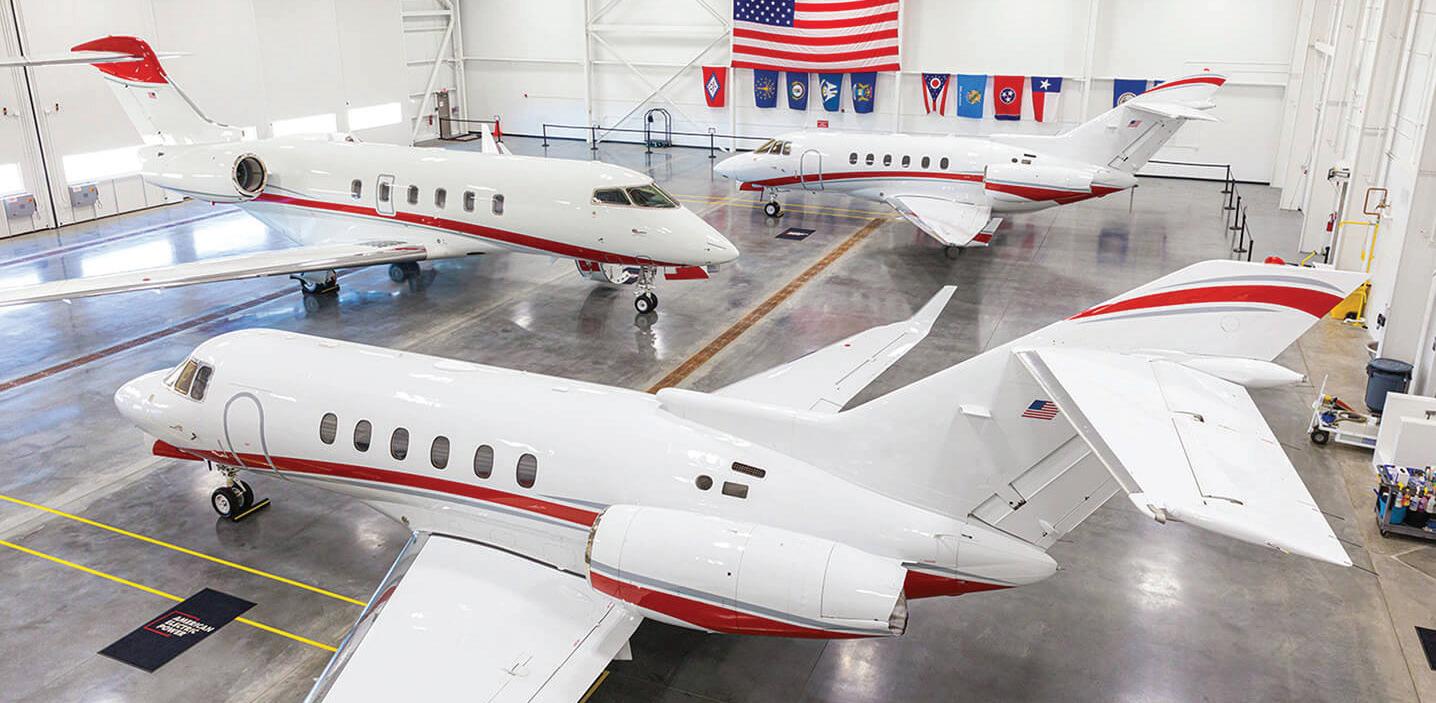
David Keys, chief pilot of Peace River Citrus Products and vice chair of the NBAA Flight Operations Committee, said he found “a completely different world” when he first moved from a now-defunct commercial carrier in the 1980s to flying for a Part 91 flight operation.
“Business aviation is more about relationships than the mechanics of the job,” he said. “It’s about customer service; you will load luggage and ask your passengers if they’d like drinks. You will clean up after them. It’s a lot more involved than merely showing up and flying the airplane.”
“Your support network isn’t very large at all compared to an airline,” added Lisa Archibald, CAM, and a commercial airline first officer who’s also worked in business aviation. “In fact, it may just be you!”
Like Keys, Archibald’s past duties ranged from lining up catering to arranging fuel loads, international permits and ground handlers. “I worked for some well-established business aircraft operators, and I’d say 90 percent of a successful trip was thanks to the pilots,” she added. “Our little team made it all happen.”
Pilots moving over to business aviation may also run into procedural and technological challenges. “There’s a lot more technology available to business aviation pilots,” Keys said, “and we need it. We don’t have the support network behind us that we did at the airlines.”
Those differences often become known during training. “You don’t want to stick out in ground school by saying, ‘that’s not how we did it at the airlines,’” Keys said. “If you keep comparing it to what you used to fly, you will struggle.
Continued on Page 22
Those making the move to business aviation from commercial airline flying may discover some flight operations are reluctant to consider them for the job. Jennifer Pickerel, vice president at Aviation Personnel International, offered several tips to overcome that challenge.
“There are misperceptions on both sides of the hiring desk,” she said. “Flight departments believe airline pilots lack the customer service skills necessary in our industry – and those are not easily taught – and some airline pilots expect business aviation flying to be easier.
“It’s generally not enough to simply say, ‘I’m retiring but not ready to stop flying,” Pickerel continued. “You need the desire to work in the business aviation environment and be receptive to what that requires. You must contribute to the operation beyond the flight deck.”
As a result, Pickerel noted, some clients will not consider applicants from the commercial airlines unless they also have previous experience in business aviation.
“That said, I encourage them to lean into that stigma,” she added. “Demonstrate respect for what the job requires and do your research. State upfront that you don’t want to be part of that stigma, but you acknowledge that it exists.”
An effective cover letter can also help convince a recruiter to take a closer look at your application. “Make it compelling and show your personality,” Pickerel said. “Show them you’ve done your research. Sell yourself enthusiastically and leave them wanting to learn more.
“It’s true that you will have a higher bar to clear,” she concluded. “Just because we’re in the same industry doesn’t mean the requirements are the same. Business aviation is a far more delicate dynamic, but you can acknowledge those differences and celebrate them.”
“Business aviation is more about relationships than the mechanics of the job.”
Continued from Page 21
Jay Johnston flew for nearly 25 years with a commercial airline before mandatory retirement. He moved three years ago to a Part 91 operator based in the northern U.S.
“Business aviation is a lot more hands-on, and of course you need to keep your primary happy,” Johnston said. “If he decides to stay an extra day somewhere, it’s ‘yes sir’ followed by what can be a lot of rearranging your personal schedule on the back end.”
Prior to retirement, Johnston consulted with a 20year industry veteran. “I knew a lot going in about what to expect,” he said. “Some of that I learned from my friend, and some was from simply envisioning the operation and thinking about what would be required.”
Johnston found that business aviation offered several upsides. “First and foremost, the owners are great people,” he said. “That’s a big factor when flying Part 91; you get to know them, you’re traveling to the same fun places they go to and you’re usually staying at or near the same hotel.
“You’re in the neighborhood of their lifestyle,” Johnston continued. “We can select our hotels that are usually much nicer than airline accommodations and optimize [rewards] points for hotels and rental cars.”
“Business aviation crews are often very well taken care of. Nice hotels, nice meals and perks that can be much better than airlines offer.”
Archibald agreed. “Business aviation crews are often very well taken care of. Nice hotels, nice meals and perks that can be much better than airlines offer.”
Like Archibald, Johnston had to get used to perform-
ing his own flight planning and monitoring his flight hours to stay ahead of training requirements.
“The airline tracks your hours and currency, and advises when you’re due for training,” Johnston said. “In this world, the chief pilot may call me and say I need to take an online international flying course and it’s up to me to select the provider and ensure I’m current.”
With that greater responsibility also comes what Johnston termed a sizable pay disparity. “That’s really the only thing I’d change,” he said. “The airline did pay me a lot more, but this is the job that keeps me flying and I’ve met some fantastic people.”
Keys and Archibald agreed the ability to develop those personal relationships is a definite advantage in making the move to business aviation.

“The airlines were a lot different when I first started flying,” Keys said. “Back in the 1980s we could interact a lot more with the flight attendants and ground crews. Now, we just lock ourselves behind the cockpit door.
“Business aviation is a lot more fun. Had I stayed with the airlines, I’d not have near the number of friends I have in business aviation today.”
DAVID KEYS Chief Pilot, Peace River Citrus Products“Business aviation is a lot more fun,” he continued. “Had I stayed with the airlines, I’d not have near the number of friends I have in business aviation today.”
“It’s nice to get to know someone and make that connection, especially in retirement,” Archibald agreed. “You never know where you might be able to help someone, or someone may help you.”
Archibald also noted that the nature of business aviation flying appeals to many pilots. “Type A people enjoy new challenges, and each flight can offer a puzzle or two that requires solving,” she said. “That can be so much fun!”
“I just fell in love with business aviation,” Keys added. “Sure, it’s not glamorous to carry bags or empty the lavatory, but it is fulfilling work. You don’t simply check in and check out; you are contributing to all aspects of the operation.”
“We all play a role outside the flight deck,” Archibald agreed. “It may be small – scheduling pilot training, managing an EFB subscription – but in business aviation, those roles must usually be completed by the pilot.
“I love being involved, so I’m involved outside the flight deck [at the airline] but that is my choice,” she continued. “It is not a choice in business aviation.”
View available aviation jobs at NBAA’s Business Aviation Jobs board at NBAA’s website, nbaa.org.
The ability to develop personal relationships is a definite advantage in making the move the business aviation. (Photo courtesy NBAA)


The Africa America Wealth Conference (AAWC) is the brainchild of Joseph Nantomah, also known as The Black Mentor. Joseph Nantomah is a sought after business and life coach. The AAWC is a gathering that attracts attendees from different continents, all with one purpose: to build wealth and leave behind a legacy.
Do you want to learn how to break generational misconceptions and false beliefs about creating wealth for you and your family? Are you interested in learning how to create prosperity that lasts? Get your tickets today!
Leaning into your financial freedom starts with understanding what you didn’t realize you needed to know. AAWC is here to help you learn, earn and return; find ways to partner together, get branded, and increase your life, business and net-worth. Once you enter the doors, everyone’s the same and everyone is looking at how they can network and do business together.


The current worldwide pilot shortage has brought many opportunities to many pilots. Long gone are the days when experienced pilots were so plentiful that employers could cherry-pick from several hundred qualified applicants for a single pilot position. The wave of retirements at the majors – coupled with heightened demand for air travel – has completely upended the market for professional pilots. Now regional airlines are offering up to six-figure hiring bonuses to pilots that have enough experience to be hired into the left seat. This of course, would not happen at a major airline where unions have made seniority as much a part of advancement as qualifications.
So for now, competition is intense for business aviation operators to hire and retain qualified pilots. The salaries being offered – while still low compared to the major airlines – is trending upwards very fast. There is also a trend to hire anyone who meets the minimum qualifications for the right seat. I definitely see a shallowing of the pilot pool when it comes to experience.
I just left my most recent full-time job as Captain on a Gulfstream IV for a new company that offered me a Captain position on a Gulfstream 550. This new job pays much better, and it starts with a new type rating for me.
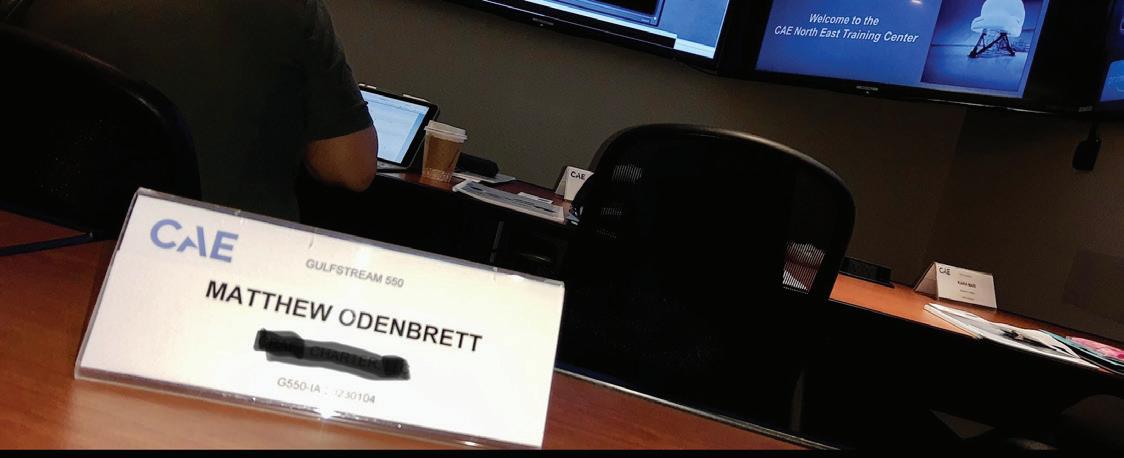
So I am now at CAE’s training facility in Morristown N.J., in a class with 10 other pilots. Several are from Netjets, while others are from smaller operations. One thing that stands out is the fact that I am the oldest student in the class. Several students are moving up from a Gulfstream IV (like me), the others have flown Challenger 605s and 300s. One is a former regional airline pilot.
Shawn - my soon-to-be sim partner – retired two years ago from the Denver Police Dept., and he decided to fly for a living as a second career. I can’t blame him for that, but I was surprised when I discovered that he holds a Commercial certificate and has slightly less than 1,500 hours total time in his logbook. He explained that the company will have him take his ATP exam on his next sim recurrent session, one year from now. Shawn spent one year at a freight operation in Denver, then came to this company a year ago and was typed in the Challanger 300. The G550 is his sec-
ond jet type rating in a year.
I was shaking my head at that. I explained to Shawn that when I was at 1,500 hours, I was only entrusted by my employer to fly charters in the Cessna 210, 303, and 310. I was allowed to sit right seat in the company’s Cessna 404. Eventually I became Captain on the C404 but not before I had surpassed the 2,000-hour mark. My employer also managed a Cessna C421C, but no one would be considered to fly that unless they had more than 3,500 hours in their logbook.
I didn’t fly the Pilatus PC-12 until I had surpassed 5,000 hours. My first jet type rating was the Cessna 500 series Citation. I paid for that out of pocket, because no one would hire me in 2008 without a type rating already in hand. I had 7,500 hours logged when I earned that type rating.
To be clear, I have literally had to fight for every paid flying position that I have worked at. I am of the “Lost Generation” of pilots who were unqualified to fly for the major airlines (in their eyes) until retirements forced them to start hiring any warm body that had an ATP and a pulse. The problem is that now I would not consider flying for them because due to my age, I would be forced by the Age 65 rule into retirement long before I could make up for the loss of income I would have to endure at a legacy carrier.
So how did we get to this pilot shortage? Let’s take a look back in history.
The airline-hiring boom of the 1980s came about because the Vietnam-era veteran pilots had reached their mandatory age 60 retirement. This led to a large number of young pilots being hired at that time. Those pilots are now retiring as they reach age 65. This sudden loss of pilots has long been known to be looming on the horizon, but no one at any of the major airlines did anything about it, and now it is too late. They were all too focused on meeting their quarterly bottom lines. Corporate myopia can be very damaging at times.
Historically, there was a flow that was observed in a pilot’s career progression. After earning a Commercial Certificate, a pilot could either get a CFI and then instruct at flight
Continued on Page 26
Continued from Page 25
schools, or get a job flying banners over beaches or maybe flying skydivers at a skydiving club to build up to the magic 1,200 hours in their logbook that was needed to be hired by a 135 operator who would be flying freight or passengers in piston twin engine airplanes. Once there, the job search continued to find an operator who would hire a pilot to fly turboprop airplanes of the day, such as King Airs, Cessna Conquests, and Merlins. When – and only when – a pilot had logged 1,000 hours of multi engine turboprop time would they be considered competitive enough to apply to a major airline.
Things started to change in the early 1990s, which is a time I personally recall. When the Cold War ended, the United States went into a recession. Three major airlines - Eastern, TWA, and Pan American folded, while at the same time the US Military was downsizing and let go of half of their pilots. There were so many pilots looking for any kind of work that employers could cherry-pick from the pool of applicants. I personally had just 1,100 hours in my logbook, and no one would even invite me to an interview.
During this time, a friend and student of mine showed me an ad from an American Eagle-branded regional airline. The ad stated that for just $24,000 a Commercial Pilot could attend their training school, and if they passed, they were guaranteed a job interview with the airline. I looked into the airline, and discovered the first-year salary for First Officer was around $18,000. In short, these regionals saw an opportunity to turn their flight training departments into profit centers by offering aspiring pilots to pay for their training, with a promise of an offer of employment if the low-time pilot passed the training program. I found the very idea insulting, and I did not apply. It didn’t make any real sense to me at the time. I was a clerk in the Air Freight business, living from paycheck to paycheck. I certainly didn’t have $24,000 lying around, and I wasn’t about to borrow that from a bank to go to work at a job that paid so low I would qualify for food stamps.
By the mid 2000s, the job market had changed again. The regional airlines were taking over routes formerly flown by the majors, and were now using Regional Jets. The supply of pilots was starting to dry up, so the carriers that had been offering PFT dropped those programs and started offering First Officer positions to anyone who had a Commercial multi-engine certificate and 250 hours total time. First year pay was still insultingly low, but those who went that route had the jump on everyone else vying for a position at the majors. But the majors weren’t hiring very many pilots, and the career flow pro-
gression was very slow. They did see a looming pilot shortage though, and the airline groups and ALPA successfully lobbied congress to up the mandatory retirement age to 65 in 2007. When this happened, the career flow progression completely stopped… for five years.
The career progression was also aggravated by congressional response to the Colgan Air accident in Buffalo, N.Y. No longer could an airline hire newbies at 250 hours and put them in the right seat. Instead, one must reach 1,500 hours before they can be hired at a 121 operation. So newly minted pilots were spending much longer at the lower echelon jobs while building enough time to get into even the regionals.
In the early 2010s, the joke amongst professional pilots was that to get hired by a legacy carrier, a pilot needed to have at least a Space Shuttle type rating and six Lunar Landings in their logbook in order to be competitive. The flow finally resumed in 2012 as airline pilots began retiring again at age 65.
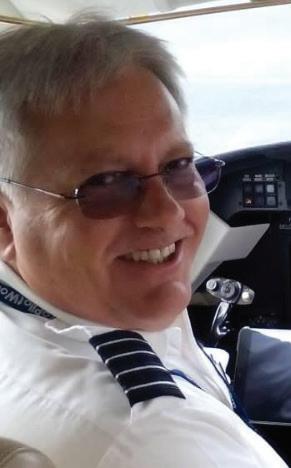
That flow of career progression is now a torrent. During the Covid shutdown, airlines offered early retirement packages to their most senior pilots, and a great many took it. The airlines were taken by surprise when travel came roaring back much quicker than had been predicted. So now airlines are vacuuming up any pilots that can meet their minimum experience requirements, which has led to many charter and corporate operations being depleted of their pilot ranks.
What a wonderful time to be an airplane pilot! If you have the minimum number of hours, you can get hired directly into the right seat of a turboprop freighter or executive charter operation. I have heard tales of pilots going into a freighter’s right seat at just 500 hours. If you can do two years of hauling boxes in an old Metroliner, you will be swept up by just about anyone when you reach the magic 1,500 hours and 1,000 hours multi engine turbine time.
One word of caution: Aviation is a cyclic business. Right now, everything is going gangbusters, and the future looks rosy to everyone. That right there is a warning flag. Aviation booms will usually go bust right when everyone is predicting rainbows and unicorns into eternity.
But for now, enjoy the ride. I know I am.
Matthew Odenbrett is a 13,000 hour ATP and CFII with Gulfstream IV, V, and Citation 500 type ratings. During his 24-year career, Matthew has served as Chief Pilot, Check Airman, and Flight Department Manager for various companies. Matthew currently works as Captain on the Gulfstream 550, and is a contract Captain on both the GIV, GV, and G550.
The National Business Aviation Association (NBAA) continues to review a notice of proposed rulemaking (NPRM) to extend requirements for implementing a new safety management system (SMS) beyond Part 121 airline operators to other commercial aviation entities, including many business aircraft operations.
The NPRM, issued Jan. 10 by the Federal Aviation Administration (FAA), would update and expand 14 CFR Part 5 SMS requirements to certain Part 21 certificate holders, Part 135 air charter operations and companies holding a letter of authorization to conduct air tour operations under Part 91.147.
SMS can assist operators in proactively identifying potential hazards and ensuring that a process is put in place to effectively manage them. The FAA has required U.S. airlines to implement SMS since 2018, with Congress calling on the agency in 2020 to extend those requirements to other commercial aviation operations.
“Safety is a core value for the business aviation community, and for nearly two decades, NBAA has been strongly supportive of the benefits that stem from the adoption of SMS,” noted association Director, Safety and Flight Operations Mark Larsen, CAM. “Further, NBAA’s participation on the FAA’s SMS Aviation Rulemaking Committee in 2010, and our contributions to that panel’s final report, helped to shape current SMS requirements.”
An effective, structured SMS is also at the core of the International Standards for Business Aviation Operations, or IS-BAO. Established by the International Business Aviation Council and its member associations, ISBAO is a recommended code of best practices designed to help flight departments worldwide achieve high levels of safety and professionalism.
“We’ve seen how SMS directly benefits the safety of business aviation stakeholders that have adopted such programs voluntarily,” Larsen continued. “Their experiences also highlight that, for any SMS to be a truly effective solution, it must be tailored to the size and complexity of the operation. Our review of the FAA’s NPRM will closely examine if such scalability would be possible under the changes proposed by the agency.”
Citing the extensive scope of operations affected by the proposal, Larsen further called on the FAA to extend the public comment period for the NPRM past the current March 13, 2023, deadline.
“We believe industry has a crucial role to play in helping make SMS a workable solution for the broad
array of operations that would be affected by this proposal,” he said. “Additional time will be needed to fully evaluate the proposed additions for Part 5 and their impact on affected stakeholders.”
Review the FAA’s SMS NPRM at https://www.faa.gov/ sites/faa.gov/files/2120-AL60-SMS_NPRM_Final.pdf .
Founded in 1947 and based in Washington, D.C., the National Business Aviation Association (NBAA) is the leading organization for companies that rely on general aviation aircraft to help make their businesses more efficient, productive and successful. The association represents more than 10,000 company and professional members and provides more than 100 products and services to the business aviation community, including the NBAA Business Aviation Convention & Exhibition (NBAA-BACE), the world’s largest civil aviation trade show. Learn more about NBAA at nbaa.org.
Continued from Page 9
who need it.
What else is very good here in the U.S., you have scholarships and the FAA and people want to help. In Russia, it’s not like that. They just want your money. Here, safety is very important. And I would like to add that everyone here, the instructors and the mechanics are very good. They are experienced and they want to keep safety as a top priority.
BAJUSA: Is the school good about bringing women into aviation?
AZ – We have one female instructor here, Lynzie (Hudson). And we have female pilots. We have one girl who got her private license in a Decathlon, in a tail wheel, and then she got her commercial license in a twin, in a Barron, and then single-engine EBB in a Pitts. She’s pretty impressive and flies a lot. We have families, and we have people who come with their kids and their dogs. The kids get to wash the planes. It’s a great community.
BAJUSA: XL is an impressive school. Thank you so much for your time.
Learn more about XL Aviation at xlaviationtailwheel.com.



